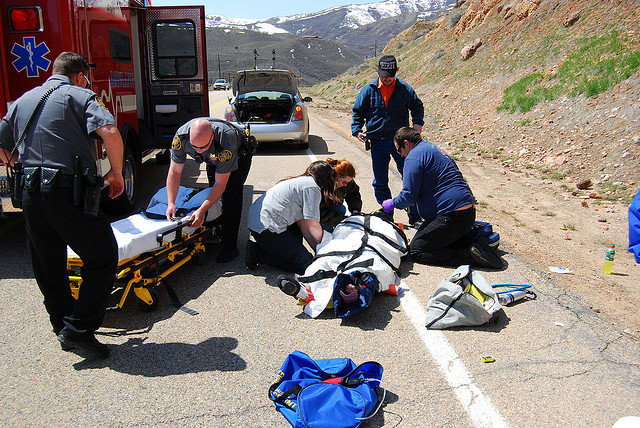Witnessing a bicycle accident can be a scary experience. If you find yourself at the scene of an accident, before you do anything else, dial 911 immediately. Before you assess the injuries of the people involved in the accident, it is important to make sure the proper authorities are notified and that the necessary medical care is on its way. 
Even very minor bicycle accidents can result in very serious injuries. Cyclists are automatically more prone to injuries than motorists, as they lack the basic protections of seat belts, airbags, and solid car body frames. Cyclists will almost always have the disadvantage when it comes to size—meaning that whatever they collide with will likely be bigger and more powerful than they are. Knowing the proper post-accident procedure can help save lives.
If you were at all involved in the accident, assess yourself first. If you were not involved in the accident, begin by assessing the scene of the accident first. Then, assess the other individual(s) involved.
Assessing the scene of the accident
Although your first instinct may be to rush to the people involved in the accident, it is crucial that you first evaluate the place involved in the accident. If the accident scene is unsafe, then the people at the scene are in further danger. The guidelines for assessing the scene of the accident include the following:
- If in traffic, make sure emergency lights are flashing, flares are burning, reflective triangles are on the road, or orange flares are waving. Stop all traffic if the safety of those involved would be jeopardized if traffic continues to flow
- Look for chemical and electrical hazards such as gasoline, oil, and power lines
- Take care to eliminate any hazard that could further endanger those involved or those who could become involved
Assessing the victims of the accident
Once you have ensured that the scene of the accident is safe, check each individual involved for bodily injuries and mental status. If there are multiple victims with varying degrees of injury severity, attend to the seriously-injured first. It is best to approach the injured victim, and, if they are conscious, introduce yourself and ask for permission to assess their injuries. When administering to an accident victim, it is best to follow the ABCDE guidelines. ABCDE stands for Airway, Breathing, Circulation, Disability, and Exposure and Environment. For a more detailed explanation of ABCDE, request a copy of the Christensen & Hymas publication, “The Utah Bicycle Accident Handbook.” Keep in mind that not all injuries may be immediately visible—especially if the biker collided with a car or an object at high-speed. Help the victim remain as calm and as stable as possible until professional medical help arrives.
These suggestions are not intended to replace medical training or to be an exhaustive list of how to respond to accident scenes. As explained earlier, always call 911 and contact emergency services as soon after a collision as possible. The less time an injured cyclist or motorist is waiting for medical attention, the better their chances of recovering fully. More in-depth knowledge should be sought in order to adequately prepare yourself for the event of a bicycle or motor accident.
Photo Courtesy of Mike Renlund and Creative Commons.
